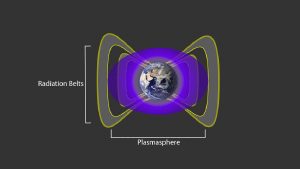Blog
Star Trekkin
30 November 2014
 Baker, et al
Baker, et alYou may have heard about a “Star Trek-like” shield that scientists have found surrounding the Earth. That’s because the University of Colorado Boulder shamefully stated as much in a press release, and websites all over the world would rather copy and paste than actually do science journalism. The press release was promoting a new paper in Nature which looks at properties of the Earth’s radiation belts.1
Basically, the authors looked at satellite data on the distribution of electrons within the radiation belts. What they found was that very high-energy electrons in the belt didn’t penetrate as close to the Earth as we had thought. There is apparently some mechanism that prevents the inward drift of these electrons. Very clearly the authors state this mechanism “does not arise because of a physical boundary within the Earth’s intrinsic magnetic field.” Apparently from that Boulder’s news service concludes that it’s a Star Trek shield.
In fact, there a likely cause for this electron barrier effect. Closer to the Earth is the magnetosphere, which contains cool diffuse plasma. This region is also sometimes known as the plasmasphere. When high-energy electrons begin drifting toward the Earth, they collide with charges in the plasmasphere, which prevents them from drifting further inward, or at least eventually cooling and becoming part of the plasmasphere itself.
To confirm the details of this interaction will require more data. But it is clear that this isn’t some kind of Star Trek shield effect. Which is unfortunate, because it would be useful to use such a shield to prevent high energy hype from reaching the popular press.
Baker, D. N., et al. “An impenetrable barrier to ultrarelativistic electrons in the Van Allen radiation belts.” Nature 515.7528 (2014): 531-534. ↩︎